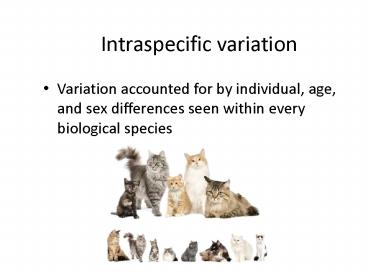Intraspecific variation - PowerPoint PPT Presentation
Title:
Intraspecific variation
Description:
Intraspecific variation Variation accounted for by individual, age, and sex differences seen within every biological species Interspecific variation Variation ... – PowerPoint PPT presentation
Number of Views:940
Avg rating:3.0/5.0
Title: Intraspecific variation
1
Intraspecific variation
- Variation accounted for by individual, age, and
sex differences seen within every biological
species
2
Interspecific variation
- Variation representing differences between
reproductively isolated groups
3
Fossil Genera and the evolution of homo
- A genus is a group of species composed of members
more closely related to each other than to
species from any other genus. - Ex dogs belong to the Canidae genus that
includes wolves, jackals, coyotes and foxes - We (and all the other extinct Homos ie
Hohabilis, Homo erectus) belong to the Genus Homo - Species that are members of the same genus share
the same broad adaptive zone. - Members of the same genus should all share
derived characters not seen in members of other
genera.
4
Ancestral and Derived (Modified) Characters
- Derived (Modified) Characters that are modified
from the ancestral condition and thus are
diagnostic of particular evolutionary lineages.
- Ancestral
- Characters inherited by a group of organisms from
a remote ancestor
5
Homologies
- More forelimb similarities. These ancestral
characteristics are called Homologies
6
Generalized and Specialized Characteristics
- Refer to the adaptive potential of a particular
trait - Generalized if a trait is adapted for many
functions a mammalian limb with five fairly
flexible digits, adapted for many possible
functions - Specialized if a trait is limited to a narrow set
of functions hand or foot suited for specialized
function of stable weight support in an upright
posture
7
Principles of Classification
- The field that establishes the rules of
classification is taxonomy. - Organisms are classified first on the basis of
physical similarities. - Basic physical similarities must reflect
evolutionary descent in order for them to be
useful.
8
Principles of Classification
- Homologies
- Similarities based on a common ancestor.
- Analogies
- Superficial similarities that are a product of
separate evolutionary responses to roughly
similar functional demands. - Homoplasy
- The process that leads to Analogies.
9
Constructing Classifications and Interpreting
Evolutionary Relationships
- Evolutionary systematics
- A traditional approach in which presumed
ancestors and descendants are traced in time by
analysis of homologous characters. - Cladistics
- Attempts to make rigorous evolutionary
interpretations based solely on analysis of
certain types of homologous characters (those
considered to be derived characters).
10
Cladogram
- A chart showing evolutionary relationships as
determined by cladistic analysis. - Its based solely on interpretation of shared
derived characters. - It contains no time component and does not imply
ancestor-descendant relationships.
Birds?
11
Shared Derived
- Relating to specific character traits shared in
common between two life-forms and considered the
most useful for making evolutionary
interpretations. - The presence of feathers in the proposed
relationship between some (theropod) dinosaurs
and birds is an example
Archaeopteryx Late Jurssaic Period 150mya
12
Clade -- car example
- From a common ancestor of all passenger vehicles,
the first major divergence is between cars and
trucks (I). - A later divergence occurs between luxury cars and
sports cars (II). - Derived features of each grouping appear after
its divergence from other groups.
13
Clade car example
- In this tree, SUVs diverge from trucks, but
like sports cars, have a decorative racing
stripe. - This is a homoplasy and does not make SUVs sports
cars. - Classifications based on one characteristic that
can appear in different groups can lead to an
incorrect conclusion.
14
Evolutionary systematics
- Traditional approach to interpreting evolutionary
relationships with the goal of producing
classifications.
15
Phylogenetic Tree
- A chart showing evolutionary relationships as
determined by evolutionary systematics. - It contains a time component and implies ancestor
descendant relationships.
16
Evolutionary systematics cladistics
- Revised view, common ancestry of birds and
dinosaurs.
17
Tempos and Modes of Evolutionary Change
- Macroevolution is the change from one species to
another - Macroevolution is only partly understandable
through microevolutionary models. - There are TWO main theories regarding
Macroevolution
18
Missing link? -- The Theory of Gradualism
- Gradualism refers to change accumulating
gradually in evolving lineages, or a series of
forms with finely graded transitional differences
between ancestor and descendant, with missing
links present
19
Punctuated Equilibrium
- Punctuated equilibrium refers to no missing
links, with real gaps representing uneven,
nongradual process of long stasis and quick
spurts - These quick spurts still take A LOT of time,
some 10,000-50,000 years.
20
Evolutionclassified
- Organizes diversity into categories and, at the
same time, indicates evolutionary relationships. - The kingdom Animalia includes 20 major phyla
(singular, phylum) - Chordata is one phyla and includes all animals
with a nerve cord, gill slits and supporting cord
along the back.
21
Mammalian Evolution
- The Cenozoic era, the Age of Mammals.
- ADAPTIVE RADIATION
- A process that takes place when a life form
rapidly takes advantage of the many newly
available ecological niches. - A species, or group of species, will diverge into
as many variations as two factors allow - Its adaptive potential.
- The adaptive opportunities of the available niches
22
Mammalian Evolution
- Characteristics
- The enlargement of the cerebrum, especially the
neocortex, which controls higher brain functions,
resulting in more nerve cells\
23
Mammalian Evolution
Monotremes
- Characteristics
- A longer, more intense period of growth in utero
Placental Mammals
Marsupials
24
Mammalian Evolution
- Characteristics
- Distinctive dentition, termed a heterodont
dentition, with 3 incisors, 1 canine, 4
premolars, and 3 molars in each quarter of mouth
25
Mammalian Evolution
- Characteristics
- Maintenance of constant internal body
temperature, warm-bloodedness, and ENDOTHERMIC
Ectothermic
26
Mammalian evolution
- Lateral view of the brain in fishes, reptiles,
and primates. - Note the increased size of the cerebral cortex of
the primate brain.































